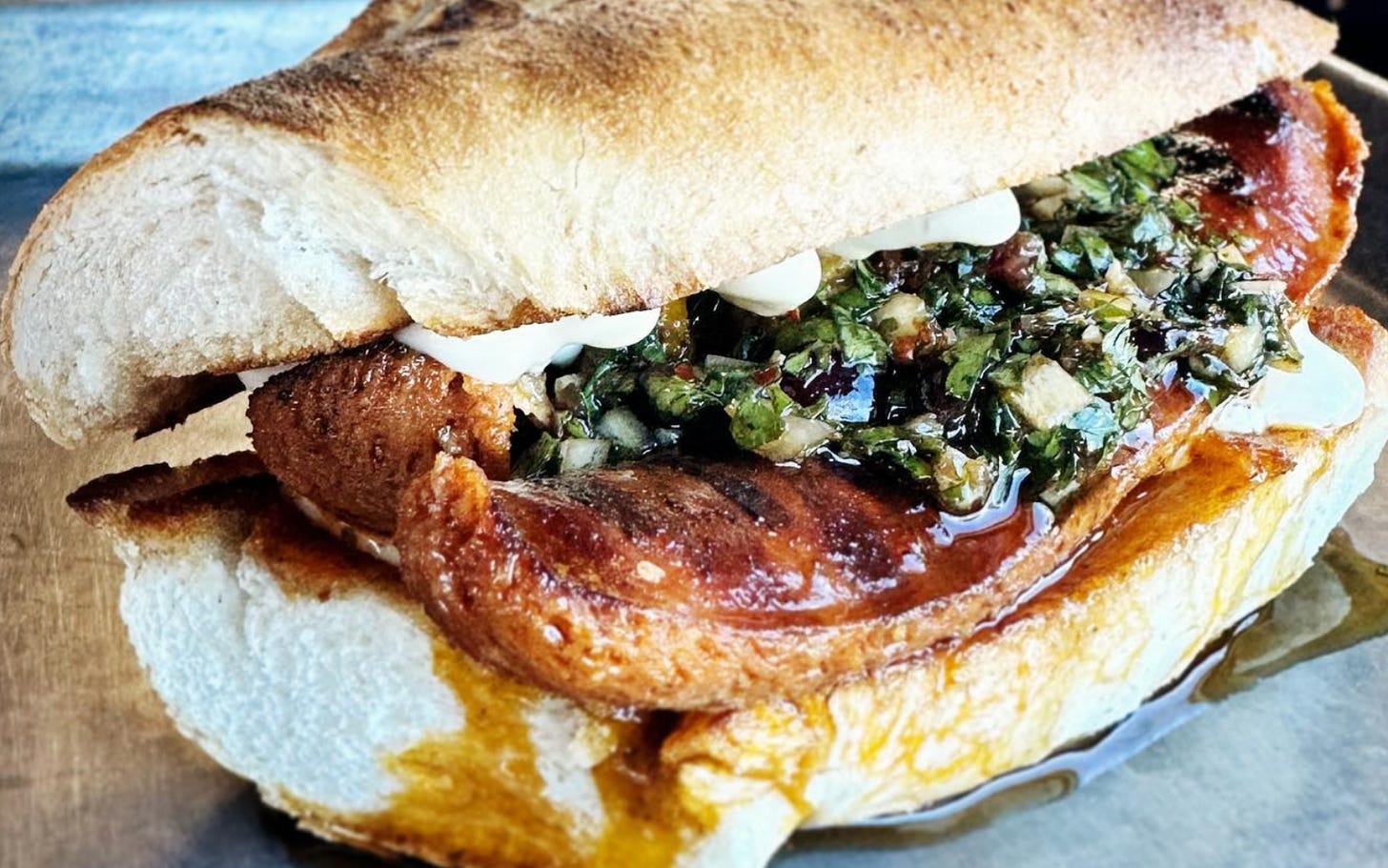Notable Sandwiches #44: Choripán
Sausage and bread: a South American staple that's just what it says on the tin
Welcome back to Notable Sandwiches, the series in which I, alongside my editor David Swanson, stumble through the strange and ever-shifting document that is Wikipedia’s List of Notable Sandwiches, in alphabetical order. This week: a South American favorite, the choripán.
Yesterday I got a dual shot—this year’s flu vaccine, and my second covid booster—so I’m writing this through a slightly feverish haze, fan on full-blast, my head a muzzy, fusty little jumble of wool. Nonetheless, time, tide and sandwiches wait for no one, so I’m going to write a slightly short ‘n’ loopy description of the choripán. If it’s awful, blame it on my present febrility; if it satisfies you, well, consider it a mark of my general febrile creativity.
And do get your booster shot; I had Covid, and I still get migraines nearly a year later. Immunity is a good thing, and feeling like shit for 24 hours is better than, I dunno, having your kidneys explode in a decade, or whatever this disease truly does.
At any rate: down to business—the very serious business of describing a sandwich beloved of the continent of South America. First, a note on its name. There are a lot of delightfully peculiar food names in this world, allusive epithets that offer no insight whatsoever into what’s contained within: toad-in-a-hole is just an egg in some bread (unless it’s sausage swimming in a Yorkshire pudding), and a sloppy joe isn’t a sex act, but a pile of meat on bread; alewives are herrings, and a Dutch Baby is a giant pancake. There’s a certain pleasure in deconstructing this kind of culinary wordplay, and far be it from me to deprive anyone of their ants on a log or devils on horseback. But there’s worth, I think, in a food that tells you exactly what it is from the jump—and the choripán is a prime example of that category.
The Sword and the Sandwich is a newsletter about serious extremism and equally serious sandwiches. Please consider supporting this work with a paid subscription:
With a choripán, you’re going to get chorizo and pán—sausage and bread. That may mean different varieties of bread in Uruguay and Argentina and Puerto Rico and South Florida’s Cuban communities, but all are fully capable of soaking up the sizzly grease of a smoky grilled sausage—generally split lengthwise—and the fresher exudations of the various salsas that adorn it. Traditional salsa criolla, a vibrant jumble of diced onion, tomatoes, and peppers, is a favorite topping; in Argentina, where the choripán is a perennial presence on the country’s ubiquitous grills, chimichurri sauce is indispensable; in Puerto Rico, you can add manchego cheese and ketchup, such is the dish’s malleability. You will find them for sale at sporting venues or from street vendors, from hole-in-the-wall cafés, or dressed up in chichi restaurants. But from Lake Titicaca to Tierra del Fuego, the choripán is a solid, no-bullshit presence, a confection of carbs and smoke and protein, as simple as its name.
Incidentally, according to this capsule history, chorizo has been kicking around Spain for centuries, an offcuts-preserving byproduct of the annual autumn pig slaughter. But it wasn’t until the sixteenth century, when the conquistadors brought back paprika from the New World (along with a lot of gold and silver, potatoes and tomatoes, enslaved human beings and syphillis) that this particular sausage took on its signature color, the fragrant russet of the oil that leaks onto your fingers. While Spanish chorizo tends to be quite firm—preserved by dry-aging—Mexican chorizo, the type used in the choripán, is softer, juicier and more yielding, far better to press between slices of puffy pán and serve up steaming.
The Columbian exchange—with its cruelties and imbalances and the inevitable shifting of seemingly static concepts once trans-oceanic commerce intervenes—is a perennial theme of this newsletter, particularly when it comes to South American meat sandwiches. (There are a lot of South American meat sandwiches!) But certain things do stay fixed no matter their context, and hunger is one of them—along with the desire to tame it quickly and simply and cheaply. Whether you prefer the alliaceous tang of salsa criolla or the herby savor of chimichurri, the choripán is an exemplar of a big and simple truth: sometimes the difference between hunger and satiety is just a few perfect bites.
Now I’m off to take a fever nap. Wishing you all a restful weekend full of smoky sausages and crusty bread to encase them.







